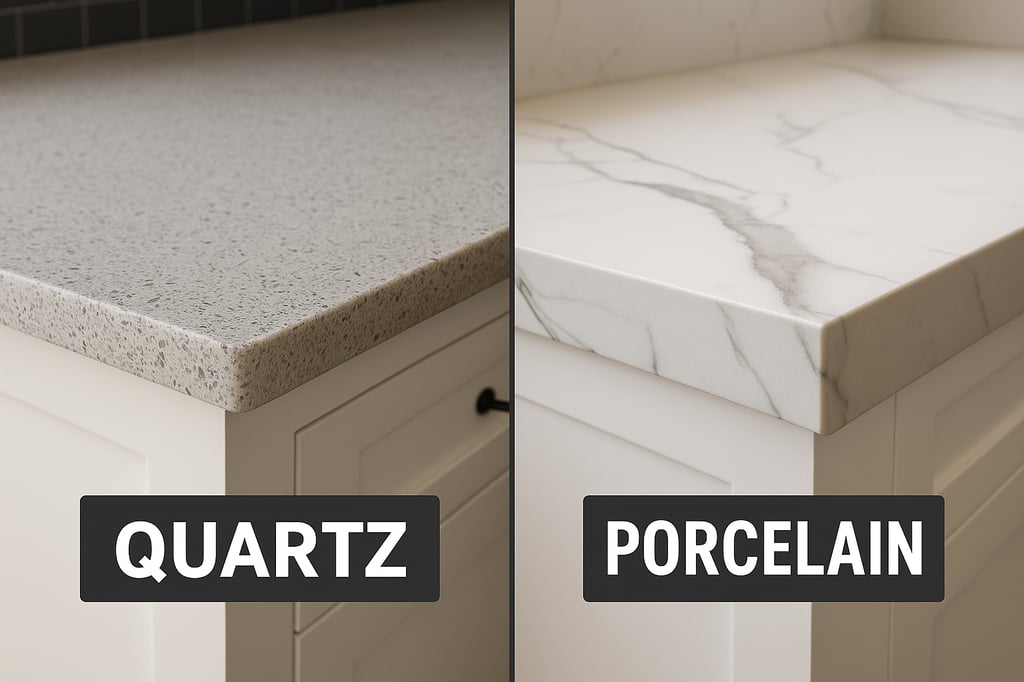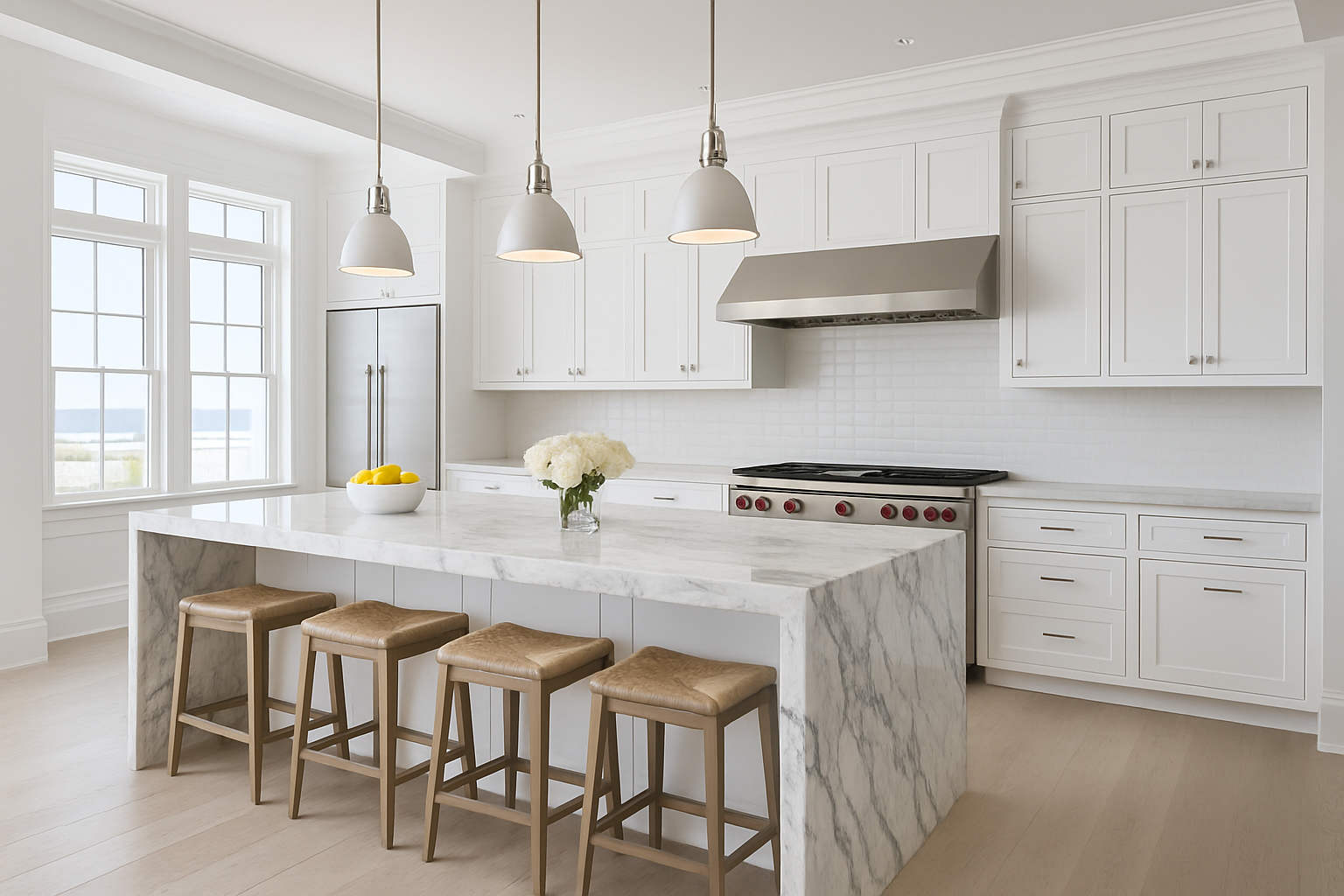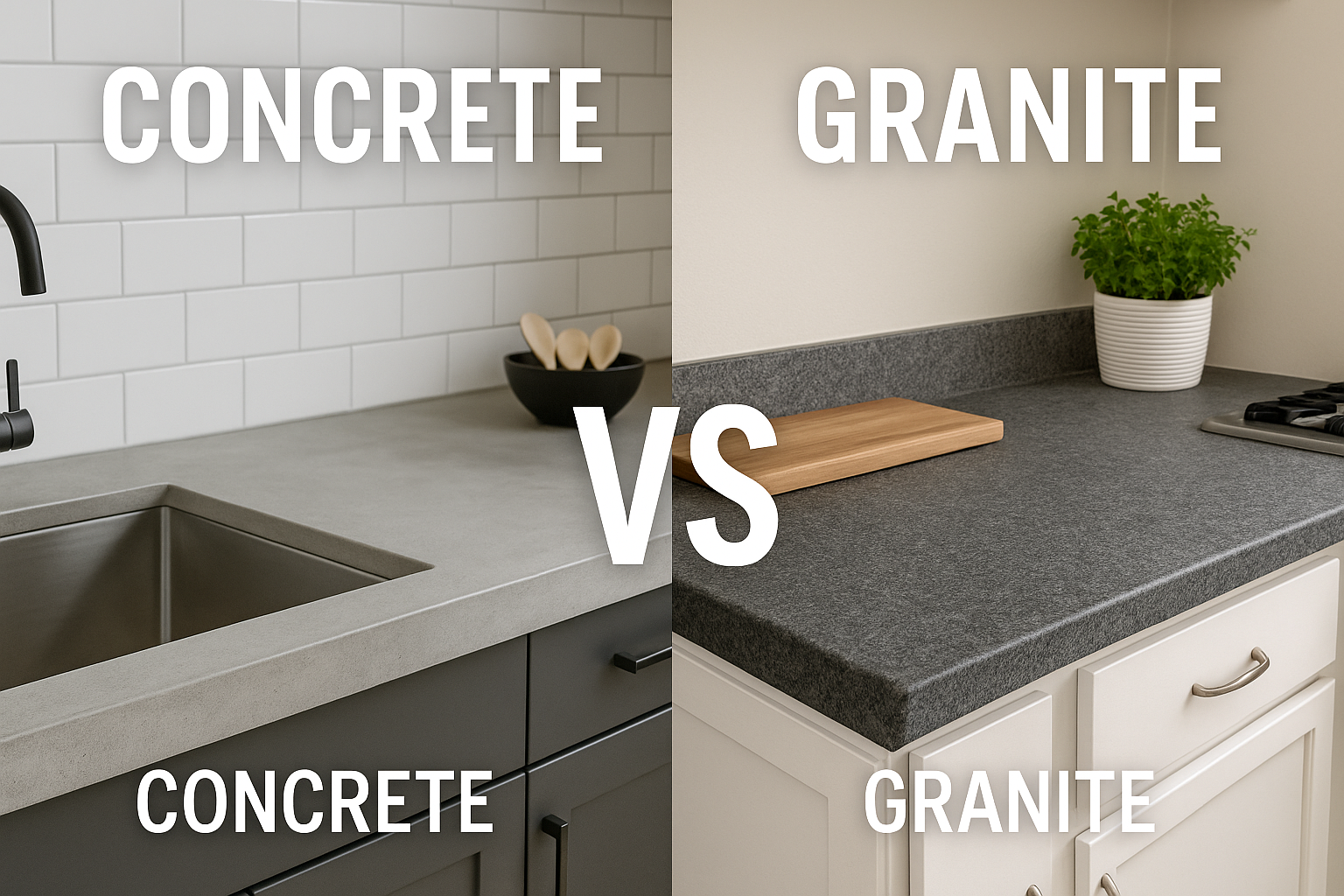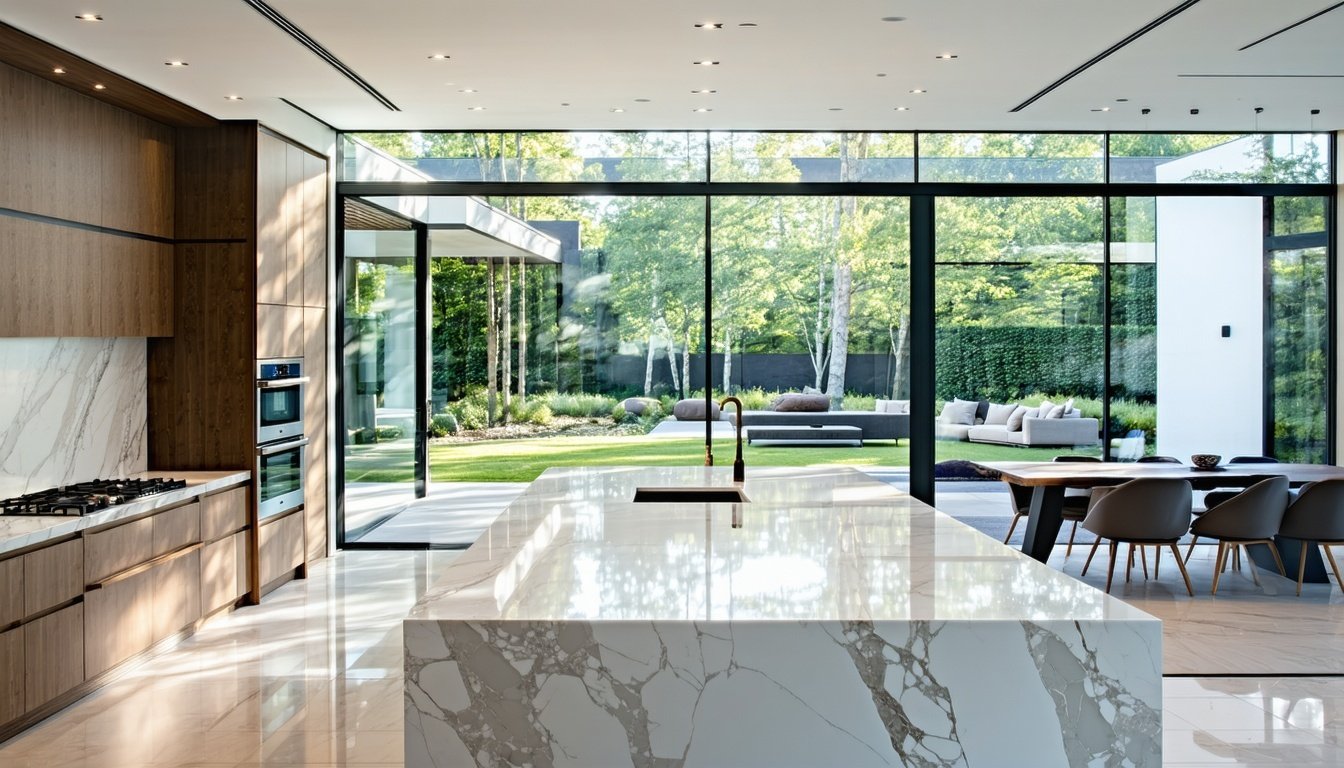Quartz vs Porcelain Countertops: What’s the Difference?

Introduction
Choosing the right countertop material isn’t easy—but it’s a big decision. If you’ve narrowed it down to quartz countertops and porcelain countertops, you’re already ahead of the game.
Both materials are stylish, durable, and high quality. But the real question is: which one fits your lifestyle—and your space?
Let’s break down the key differences between quartz and porcelain countertops so you can make a confident decision. And if you’re still unsure, Granite Guy Inc. is here to help. We proudly serve the Greater Boston and MetroWest areas—and you’re always welcome to visit our showroom on Route 9 in Southborough.
What Are Quartz and Porcelain?
Quartz countertops are engineered using 90–95% ground natural quartz mixed with resins. Quartz slabs are created from quartz chips and dust bound with resin, resulting in a hard, non-porous surface that doesn’t need sealing and is highly stain resistant. Quartz countertops often have a speckled appearance, but modern designs can also mimic natural stone, including marble.
Porcelain countertops—sometimes referred to as sintered stone—are made from refined clay (often called China clay or kaolinite) and raw materials like silica and feldspar. These porcelain slabs are fired at extremely high temperatures, making them dense, lightweight, moisture-resistant, and incredibly durable. Porcelain can mimic natural elements like marble, wood, concrete, or even metal, and it’s used in both indoor and outdoor settings—including bathroom countertops and wall cladding.
Aesthetics and Design Flexibility
Both materials offer a ton of design flexibility:
-
Porcelain countertops come in a vast array of colors, finishes, and patterns. They’re great at mimicking natural stone countertops or offering bold, modern looks. Just note that most patterns are only surface deep.
-
Quartz countertops provide a uniform appearance with consistent color throughout. Newer options offer rich, deep veining to mimic natural quartz crystals or polished stone.
Bottom line: Both quartz and porcelain countertops give you creative control. Porcelain leans bold and modern. Quartz offers a consistent, clean style.
Edge Profiles
The edge style can change the entire vibe of your countertops:
-
Quartz counters allow for eased, bullnose, bevel, ogee, waterfall, and more. These work well for everything from farmhouse to ultra-modern styles.
-
Porcelain slabs usually stick to squared or mitered edges. Shark nose profiles can create a floating effect. Mitered edges are often used to disguise printed surface patterns.
Finish Options
-
Quartz finishes: polished quartz (glossy), honed (matte), leathered (textured with a soft sheen)
-
Porcelain finishes: matte, gloss, high-gloss glaze, or textured (baked in for durability)
Neither material requires sealing. Quartz may scratch slightly more easily. Porcelain, though harder, can chip if mishandled—especially along jagged edges.
Durability and Maintenance
Both are highly durable, but each excels differently:
-
Heat Resistance:
-
Quartz surfaces handle moderate heat but placing hot pots directly on the surface can damage it. Use trivets.
-
Porcelain is extremely heat resistant—even with high temperatures and direct sunlight. It’s great for outdoor use.
-
-
Scratch Resistance:
-
Quartz is scratch resistant but not completely scratch proof. A cutting board is always a good idea.
-
Porcelain’s dense surface offers excellent scratch resistance, but edges can chip if struck.
-
-
Cleaning:
-
Both quartz and porcelain countertops are non-porous and hygienic.
-
Regular cleaning with a soft cloth and mild soap works best. Avoid harsh chemicals.
-
Real-World Performance: Heat & Scratches
Quartz countertops are a solid choice for high-traffic kitchens. They’re highly stain resistant and hold up well to everyday wear—especially with basic care like using trivets and cutting boards.
Porcelain countertops perform even better under high temperatures and sunlight. That makes them ideal for outdoor kitchens or sunny rooms. The tradeoff? Their edges can chip more easily, especially if installed without reinforcement.
If your day-to-day includes cooking with hot pans or hosting outdoors, porcelain may win. If you want low-maintenance and toughness with style, quartz may be better suited.
Installation
The installation process is one of the biggest differences between these materials:
-
Quartz countertop installation requires reinforced cabinetry. It’s heavier and more forgiving during fabrication but must be handled by professionals.
-
Porcelain countertops are lighter but more fragile. They may be installed over existing countertops, which can save time and money. Just make sure the cabinetry is stable and that fabrication includes design-specific edge work.
Either way, professional installation is a must.
Cost Comparison
Here’s the general price range per square foot:
-
Quartz countertops: $60–$150+
-
Porcelain countertops: $55–$120
Porcelain countertops cost a bit less upfront, but the installation can be more complicated and drive costs up. Quartz might cost more depending on brand and finish, but it's easier to install and holds long-term value.
Environmental Impact
-
Porcelain is made from natural materials and may be recyclable. It’s one of the more sustainable countertop materials.
-
Quartz, while engineered, has brands that now use recycled content and low-VOC adhesives.
Natural stone countertops like granite or marble are beautiful, but their quarrying and sealing needs can make them less sustainable.
Design Trends & Innovations
-
Porcelain slabs are trending in large-format designs with minimal grout lines. Great for contemporary bathrooms or waterfall islands.
-
Quartz countertops continue to evolve with polished quartz finishes and honed textures that mimic natural stone or concrete. These quartz surfaces offer stylish durability.
Both quartz and porcelain countertops now feature integrated sinks, wall cladding, and ultra-custom finishes.
Repair & Replacement
-
Quartz is easier to refinish or repair. Scratches and light damage can often be fixed without replacing the whole surface.
-
Porcelain, while tough, can be tricky to repair if chipped. Because many designs are printed, damage is sometimes more visible.
ROI and Resale Value
Quartz countertops tend to offer better ROI, with resale recovery around 80%. They're seen as a premium upgrade and valued for being stain resistant and low maintenance.
Porcelain countertops bring strong resale value too, especially in outdoor or bathroom applications. ROI is typically around 60%, but demand is growing as more homeowners embrace porcelain’s benefits.
Quick Comparison Chart
| Feature | Quartz Countertops | Porcelain Countertops |
|---|---|---|
| Look | Uniform, marble-like, deep veining | Mimics natural materials or bold looks |
| Edge Profiles | Many available | Mostly squared, mitered, shark nose |
| Finish Options | Polished, honed, leathered | Matte, gloss, high-gloss glaze |
| Heat Resistance | Moderate (use trivets) | Excellent for extreme temperatures |
| Scratch Resistance | Very good | Excellent but edges can chip |
| Outdoor Suitability | Limited unless designed for it | Excellent (UV and weather-resistant) |
| Installation | Heavier but more forgiving | Lightweight but needs care |
| Eco-Friendliness | Varies by brand | Generally more sustainable |
| Price Range | $60–$150+ per square foot | $55–$120 per square foot |
Still Deciding? Come Visit Granite Guy Inc.
Whether you're leaning toward porcelain and quartz countertops or still figuring out what fits best—we’ve got you covered.
Come visit us at 43 Turnpike Road, Southborough, MA (right on Route 9). We’ll walk you through your options, help you weigh porcelain vs. quartz in person, and give you honest advice based on your space and lifestyle.
Serving Greater Boston, MetroWest, and all of New England.
Call (508) 460-7900 or stop by the showroom. Let’s build your dream kitchen—or bathroom—together.
important one in which you have to weigh the pros and cons of each material. If you have narrowed down your selection to quartz and porcelain, congratulations! The battle is half over.
While you explore your options, it’s good to list out the benefits and drawbacks of each so you can come up with one final choice. Both are high-quality, stylish and durable materials but there are some things that set them apart. Here’s a look at the key differences to help you make the best decision possible when remodeling your kitchen. Of course, your quartz installers in Framingham can also guide you along.
The Nature of Quartz and Porcelain
Quartz countertops are engineered stone products comprising between 90 and 95 percent ground natural quartz, offset by small amounts of polymer resins. These substances come together to form a hard, non-porous surface that’s stain resistant and that doesn’t need regular sealing.
Porcelain countertops are a kind of ceramic derived from clay; however, this material is fired at far higher temperatures to result in a dense, durable, moisture-resistant surface. Even though it’s dense, it’s surprisingly lightweight. You have your choice of many colors and patterns that can resemble the look of other materials such as wood or marble.
Flexibility in Aesthetics and Design
In regards to appearance and design flexibility, quartz and porcelain both have a lot to offer consumers. Many homeowners like quartz for its consistency in color and pattern, resulting in a uniformity in appearance that spans your whole countertop. That said, the patterns and colors are well controlled in the manufacture of porcelain countertops, allowing them to easily replicate the aesthetics of natural stones or other materials. As such, you get virtually limitless design possibilities!
Durability and Maintenance
Quartz and porcelain are both very durable and long-lasting. That said, quartz is slightly more susceptible to heat damage compared with porcelain. When it comes to maintenance, both materials are less at risk for harboring bacteria due to their non-porous nature. You can choose them with confidence knowing they are both hygienic choices for any kitchen. Porcelain is a bit easier to maintain, though. All you have to do is wipe it down with mild soap and warm water.
In the end, you really can’t go wrong with either quartz or porcelain countertops because they offer unique benefits. The one you select will depend on your lifestyle, personal style, and kitchen needs.
Contact Granite Guy
Whether you love the uniformity of quartz or the versatile appearance of porcelain, Granite Guy can ensure a seamless installation in your kitchen. Just contact our porcelain fabricators in Southborough today at 508-460-7900.


